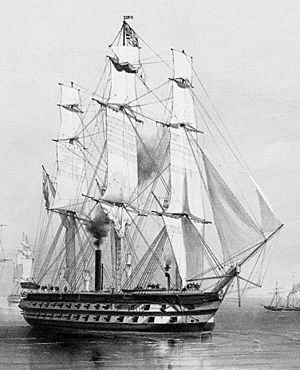HMS Blenheim (1813) facts for kids

HMS Blenheim, c. 1855
|
|
Quick facts for kids History |
|
|---|---|
| Name | HMS Blenheim |
| Ordered | 4 January 1808 |
| Builder | Deptford Dockyard |
| Laid down | August 1808 |
| Launched | 31 May 1813 |
| Fate | Broken up, 1865 |
| General characteristics | |
| Class and type | Vengeur-class ship of the line |
| Tons burthen | 1747 tons bm |
| Length | 176 ft (54 m) (gundeck) |
| Beam | 47 ft 6 in (14.48 m) |
| Depth of hold | 21 ft (6.4 m) |
| Propulsion | Sails, 1847 Steam Screw |
| Sail plan | Full-rigged ship |
| Armament |
|
HMS Blenheim was a large sailing warship. She was part of the Royal Navy of the United Kingdom. This ship was built a long time ago. She was launched in 1813. She was a 74-gun third-rate ship of the line. This means she was a powerful warship. She carried 74 cannons on her decks. Her job was to fight in naval battles.
Contents
Early Life and Service
Blenheim was built at Deptford Dockyard in England. She was launched on May 31, 1813. For many years, she served as a regular warship.
By 1831, Blenheim was used for harbour service. This means she stayed in port. She helped with tasks like training or storage. She was not actively sailing the seas for battles.
In June 1841, a sad event happened. Her captain, Humphrey Fleming Senhouse, passed away. He became ill with a fever. This happened after he was involved in operations in Canton, China.
An Unlucky Collision
On March 20, 1847, Blenheim had an accident. She crashed into another British ship. This ship was called the Cactus. The collision happened in the River Thames. Blenheim was pushed onto the riverbank in Essex.
A small boat called HMS Monkey tried to help. It was a tugboat, used to pull larger ships. But Monkey also crashed into Blenheim. Then Blenheim hit another ship. This ship was called the Agility. The Agility was badly damaged. The Monkey had to help beach Agility. This stopped Agility from sinking. Later, Blenheim was pulled free. She was taken to Woolwich, Kent, for repairs.
New Power: Steam!
In 1847, Blenheim got a big upgrade. She was changed to use screw propulsion. This meant she had a propeller powered by a steam engine. This was a new technology. It allowed her to move without relying only on sails. This made her faster and more reliable. She became a 60-gun steam screw vessel.
War in the Baltic
In 1854 and 1855, Blenheim saw active service again. She sailed in the Baltic Sea. This was during the Crimean War. During this time, she was hit by enemy fire. A 32-pounder cannonball struck her mast. It became stuck inside the mast.
The End of Her Journey
After a long career, Blenheim was no longer needed. In 1865, she was broken up. This means the ship was taken apart. Her materials were reused or scrapped.
See also
- Patricio Lynch, Chilean sailor on the Blenheim


